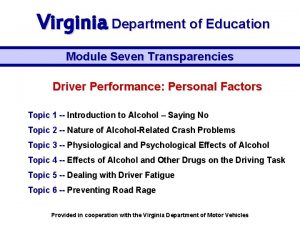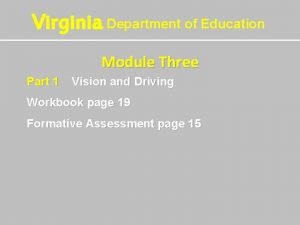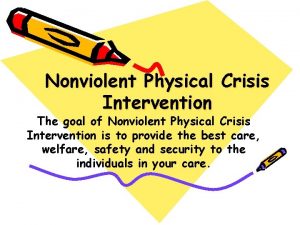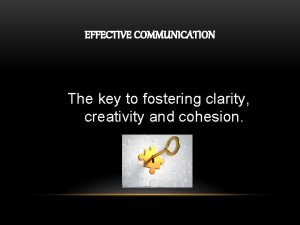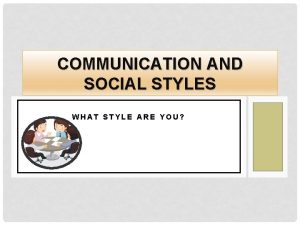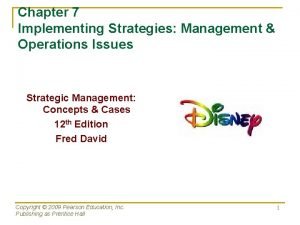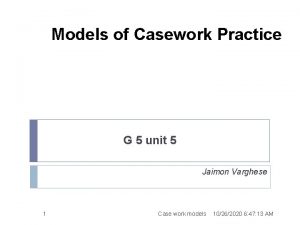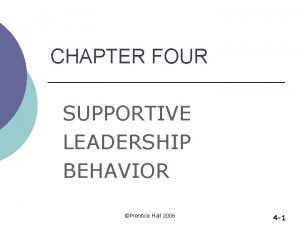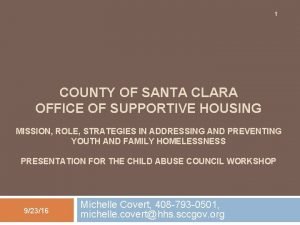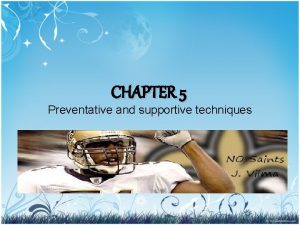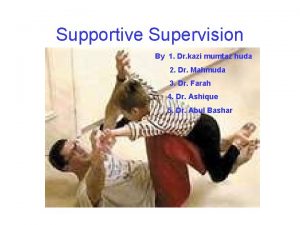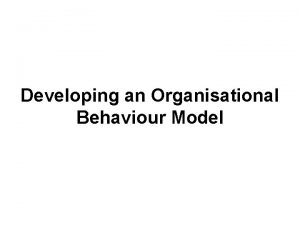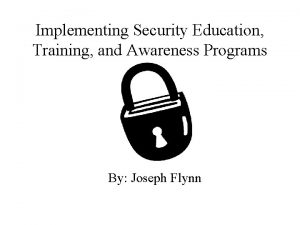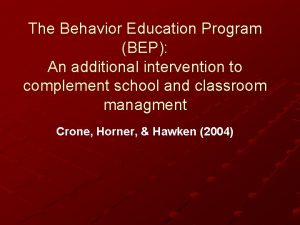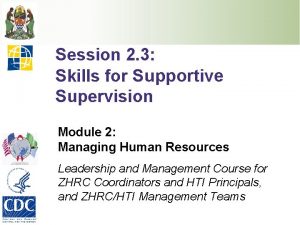Supportive Pathways Module 5 Supportive Pathways Education Program



























































- Slides: 59

Supportive Pathways Module 5

Supportive Pathways Education Program Module 5 Responding to Altered Behaviour

Objectives To understand that behaviours may occur when interacting with persons who have dementia To discuss strategies to prevent and intervene when behaviours including aggression occur To learn a problem solving approach to support persons with dementia who are distressed To consider delirium as a cause if there is a change in behaviour

All Behaviour Has Meaning Behaviour is a means of communication Our challenge is to discover what they are communicating

Behaviour Mapping Be a detective

Three Factors to Consider Physical Causes (diseases) The Environment The Person

Physical Causes Is the behavior related to: • medical history, chronic pain, psychiatric illness? • depression or delirium? • UTI, pneumonia, constipation, dehydration, acute pain? • medications such as antipsychotics? • changes related to the type of dementia they have? • what the disease has taken away?

The Person Is the behavior related to: • fears (e. g. post traumatic stress)? • hunger, thirst, other unmet needs such as intimacy? • things that upset them (triggers)? • boredom – nothing to do? • their personality, family relationships, culture or religion? • abilities/disabilities to understand, communicate or function? • past routines/ lifestyle (e. g. went for a daily walk outside)?

The Environment Is the behavior related to: • a rushed, noisy, hospital-like environment? • unfamiliar caregivers/surroundings? • no opportunity for choices or to do something? • task focused versus resident focused care culture? • minimal social interaction with staff?

What is the Fourth Factor?

The Fourth Factor - You! Is the behavior related to: • how you react to the behavior? • your approach (beliefs and values)? • your non-verbal communication? • whether you anticipate their needs? • the way you reinforce the behavior? • a belief that medications are our first option? • your willingness to make their day and time special?

Do You Have a Pet Peeve? What behaviour causes you to react?

How Can We Support The Client with Dementia? Behavior can be an indication that the person with dementia is distressed and needs our support.

We need to ask …. Is this behaviour a problem? Whose problem is it? When do we need to intervene?

Intervene When the Behaviour: Could cause harm to themselves Could cause harm to others Interferes with the rights of others (Peaceful enjoyment of their home)

How Should We Respond? • Ask: Do we HAVE to do something right now? ‘So what’ if they don’t want their bath today? • Follow: the ‘Path of Least Resistance’ (Whatever works) Do we have tools to help avoid causing distress?

What is in the Caregiver’s Toolbox? • Knowledge • Personal Strengths • Caring/Patience • Sense of humor • Communication skills • Supportive environment • Creativity • Team support

Support Strategies Use a gentle tone and touch Reassurance A visit from family or friend Marlene Collins 2009 Smiles Telephone call Feeling helpful & needed

Support Strategies Cup of Coffee / Food Helping Distracting Diffusing Talking Agreeing / Don’t argue Hope for a better day Marlene Collins 2009

Support Strategies Change caregivers Change approach ”If you don’t insist they won’t resist” Source Unknown Adapt Warmth or comfort item Marlene Collins 2009 Ensure opportunities for a good sleep Come back later

The Art of Positive Redirection Don’t tell them “they can’t”. Don’t say “no”. Offer a positive alternative to what they want to do. “Come with me. . . ”

Are Some Behaviors Normal? Rummaging Hoarding What are they? Walking (often wrongly referred to as wandering) Marlene Collins 2009

Support Strategies You cannot medicate for these, nor should you want to! Instead … we need to find ways to support their needs Marlene Collins 2009

Distressed Clients - Wandering Get out Go Home Constipation Walking ‘Wandering’ Looking for Bathroom Marlene Collins 2009 Back Pain

Support Strategies for “Wandering” Have up to date photo, alert neighbours Meet needs Register with “Safely Home” Program Daily walks Secure environment Use of new technology Distraction Marlene Collins 2009

Where to Search Most are attempting to return home To places in their past “Florida Factor”- travel south Follow the “path of least resistance”. They go until they “get stuck”

Distressed Clients - Sundowning Change in Circadian Cycle Decreasing light levels Sundowning Instinct to find shelter and warmth Marlene Collins 2009 Fatigue

Support Strategies for “Sundowning” Short afternoon nap Walking Validation Increase lighting to lessen shadows Increase staff at this time. Keep active and distracted Quiet activities. Prevent overstimulation from TV, Radio

Distressed Clients - “Calling Out” Cold / Soiled Lonely Hungry Calling Out Pain Illness Marlene Collins 2009 Lost Confused

Support Strategies for “Calling Out” Behaviour mapping to determine cause Increase contact with the person Manage pain Meet needs (e. g. hunger, thirst, toileting) Quiet activities

Distressed Clients - Anxiety Confused Lost Worried about responsibility Marlene Collins 2009 Worried about Family Anxiety Looking for what to do next

Support Strategies for “Anxiety” Give them a job Allow them to be with you Reassurance Phone call to family/friend Familiar environment

Distressed Clients – Sleep Disturbance Fear Anxiety Change in sleep pattern Pain Noisy environment nursing “rounds” Sleep Disturbance Depression Hunger, thirst, need to go to bathroom

Support Strategies for “Sleep Disturbance” Limit daytime naps Monitor or door alarm at home Bedtime routine Manage pain Avoid caffeine Night light Limit routine rounds

Distressed Clients - Displays of Sexuality Decreased judgement, impulse control Unmet need for touch Disruption of neural pathway related to sex drive Displays of Sexuality Misinterpretation of caregiver actions Forgot recent past Medical cause, UTI, vaginitis

Support Strategies for Sexual Expression Distraction Take to a private area Close monitoring and supervision Provide touch in other ways Family involvement and education Non-judgmental staff

Inappropriate Clothing Could be a Trigger

Distressed Clients - Aggression Frustration Saying “No” Anger Personality Lost and fearful Aggression Pain Approach Marlene Collins 2009 Incontinence Confused, loss of control Illness

Support Strategies for “Aggression” Distract and diffuse Consistent caregivers Respect personal space Behaviour mapping to determine cause Manage pain Listen to “no” verbal or non-verbal Don’t argue

“Choice and Challenge” Video As you watch the video clips look for the “triggers“ causing the aggressive behaviour • • • Noise Rushing Too many caregivers No choices given Rough care - face washing Others?

Signs of Distress and Possible Crisis Watch for: • Calling for help • Trying to leave • Tense muscles, clenched teeth, clenched fists • Increased questioning • Louder, faster talking or cursing • Walking faster • Interfering with others

Crisis Cycle Crisis De-escalation Trigger Baseline Escalation Recovery

Interventions Only intervene if risk to self or others Don’t gang up on the person Use staff they know best Remove the victim rather than the aggressor One person talks

Debriefing • Help to realize that the situation was not personally directed • Empathize • Should be about learning and problem solving not blaming

Medications as a Last Resort Did you notice that … medication was not listed as a strategy for altered behaviors in our tool kits? Why would that be? Medication has to be used appropriately – right reason/right dose

Appropriate Use of Antipsychotics What is all the fuss? • In the past antipsychotics have been used to help manage behaviours for persons with dementia but with more evidence and research this is now being reconsidered

Are Antipsychotics Effective For…? • Interfering with other residents - NO • • Inappropriate dressing/undressing - NO Perseveration, doing something over/over - NO Repetitive screaming/calling out - NO Eating items unsafe to eat - NO Trouble sleeping - NO Voiding, etc. in inappropriate places - NO Elopement (trying to leave) - NO Poor social skills - NO That’s why we need other strategies

Antipsychotics - Possible Hazards • Decrease in cognitive function and the ability to engage • Mobility impaired - increase in falls • Metabolic implications - diabetes • Strokes/Aspiration Pneumonia/Cardiac problems • Mortality (death) Therefore…. Health Canada issued Warnings about the use of Antipsychotics

The Appropriate Use of Antipsychotics should only be considered when: • the person has a mental illness or a psychosis (e. g. delirium) • the person is at risk of harming themselves/others (and everything else has been tried) Antipsychotics • must be reviewed frequently • used at the lowest dose possible • used for the shortest time possible then gradually reduced and discontinued

Safety in Caregiving Prevention is the best strategy

Safety in Caregiving Attending to a client in a wheelchair From the side is safer

Safety in Caregiving Hair pulls, pinches and bites Press in rather than pull away

Safety in Caregiving Releasing yourself from a grab Frail Elder - effective to distract or wait Strong aggressive grab - use element of surprise to get out of grip.

Safety in Caregiving Moving away from a punch • Block the punch with two hands • Move away from the person • Do not grab the person’s hand

Safety in Caregiving Releasing from a choke • Quickly raise both of your arms • Rotate away to safety

Use your Knowledge-Case Studies If breaking into groups Come up with a plan. Appoint a recorder and a reporter Discuss the assigned case Identify other information you would need to obtain

Goals for Care To help clients feel content and secure. Reduction or elimination of “triggers” that lead to distressed behaviours. To interact effectively with the person when behaviors occur. Aim for a win/win solution.

Learning • What is one thing you learned that will change how you support a person with distressed behaviour?

Questions? Please refer to your handouts – includes references
 C device module module 1
C device module module 1 Module 10 topic 4 drivers ed
Module 10 topic 4 drivers ed Module 7 topic 3 drivers ed
Module 7 topic 3 drivers ed Module 11 topic 1 insuring a vehicle
Module 11 topic 1 insuring a vehicle Module 8 topic 1 drivers ed
Module 8 topic 1 drivers ed Module 3 topic 4 basic maneuvering steering and braking
Module 3 topic 4 basic maneuvering steering and braking Standard 4 part 1 a: vehicle balance & control
Standard 4 part 1 a: vehicle balance & control Drivers ed module 5 topic 1
Drivers ed module 5 topic 1 Curriculum guide for driver education in virginia module 8
Curriculum guide for driver education in virginia module 8 Principle of supportive relationships
Principle of supportive relationships Supportive communication examples
Supportive communication examples What is supportive stance
What is supportive stance What is supportive communication
What is supportive communication Tissue ward movement
Tissue ward movement Emotive style communication
Emotive style communication Amiable strengths and weaknesses
Amiable strengths and weaknesses Types of discipline
Types of discipline Creating a strategy supportive culture
Creating a strategy supportive culture Dominance continuum
Dominance continuum Four basic tissues
Four basic tissues Directive behavior and supportive behavior
Directive behavior and supportive behavior Creating supportive environments smoking
Creating supportive environments smoking Social case work models
Social case work models Supportive stance position posture proximity
Supportive stance position posture proximity High quality supportive environments
High quality supportive environments Supportive leadership behavior
Supportive leadership behavior Santa clara county office of supportive housing
Santa clara county office of supportive housing Cpi postvention is used for
Cpi postvention is used for Collegial model depends on
Collegial model depends on Supportive tissue
Supportive tissue Cpi training coping model
Cpi training coping model The supportive techniques are
The supportive techniques are What is supervision
What is supervision Supportive
Supportive Autocratic model diagram
Autocratic model diagram Supportive housing providers association
Supportive housing providers association High directive and low supportive behavior
High directive and low supportive behavior Fortune society scattered site housing
Fortune society scattered site housing What is rational detachment
What is rational detachment Venn diagram formal education and nonformal education
Venn diagram formal education and nonformal education Difference between health education and health information
Difference between health education and health information Types of extension education
Types of extension education Define and explain tech-voc
Define and explain tech-voc Tata education excellence program
Tata education excellence program Professional development rockefeller college
Professional development rockefeller college Prince william county public schools specialty programs
Prince william county public schools specialty programs Ladderized education program
Ladderized education program Security education training and awareness seta program
Security education training and awareness seta program Texas drug offender education program test answers
Texas drug offender education program test answers Nsa cyber security internship
Nsa cyber security internship Juvenile justice alternative education program
Juvenile justice alternative education program Naacls accredited cytogenetics education program
Naacls accredited cytogenetics education program Secondary engagement programme
Secondary engagement programme Kansas migrant education program
Kansas migrant education program Intel education program
Intel education program Fefp
Fefp Educ4197
Educ4197 Fema higher education program
Fema higher education program Program plan uon primary teaching
Program plan uon primary teaching Behavior education program
Behavior education program


